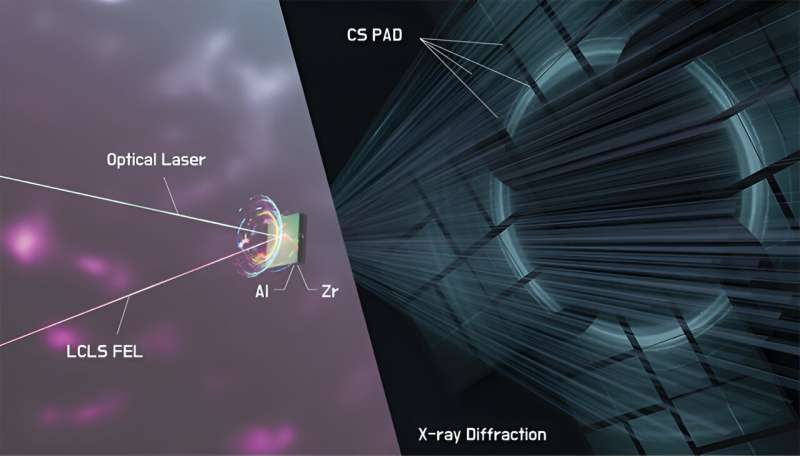This article has been reviewed according to Science X's editorial process and policies. Editors have highlighted the following attributes while ensuring the content's credibility:
fact-checked
peer-reviewed publication
trusted source
proofread
Lasers deliver powerful shocking punch in material experiments

Shock experiments are widely used to understand the mechanical and electronic properties of matter under extreme conditions, like planetary impacts by meteorites. However, after the shock occurs, a clear description of the post-shock thermal state and its impacts on material properties is still lacking.
Lawrence Livermore National Laboratory (LLNL) scientists used ultra-fast X-ray probes to track the thermal response of aluminum and zirconium on shock release from experiments and found the resulting temperatures were much higher than expected. The research is published in the Journal of Applied Physics.
A shock wave is a large-amplitude mechanical wave across which pressure, density, particle velocity, temperature and other material properties change abruptly as the wave travels through the material. The shock compression process is thermodynamically irreversible, where a substantial portion of the energy in a shock wave goes into raising the entropy and temperature of the material.
The team used diffraction patterns from 100-femtosecond X-ray pulses to investigate the temperature evolution of laser-shocked aluminum-zirconium metal film composites at time delays ranging from 5 to 75 nanoseconds driven by a 120-picosecond short-pulse laser.
"We found significant heating of both the aluminum and zirconium after shock release, which can be attributed to heat generated by inelastic deformation," said LLNL principal investigator Harry Radousky, a co-author of the study.
As it turns out, a conventional hydrodynamic model that uses typical descriptions of aluminum and zirconium mechanical strength and elevated strength responses (which might be attributed to an unknown strain rate) did not fully account for the measured temperature increase, which suggests that other strength-related mechanisms could play an important role in thermal responses under shock wave loading/unloading cycles.
"What we found is that a significant portion of total shock energy delivered by lasers become heat due to defect-facilitated plastic work, leaving less converted to kinetic energy," said LLNL scientist Mike Armstrong, another co-author of the study. "This heating effect may be common in laser-shocked experiments but has not been well acknowledged. The high post-shock temperatures may induce phase transformation of materials during shock release."
Armstrong said another potential application of the study is preserving magnetic records from planetary surfaces that have a shock history from frequent impact events.
Using the Matter in Extreme Conditions instrument at the Linac Coherent Light Source, the team found results showed much higher residual temperatures than expected from standard hydrodynamic release simulations, indicating there are other heat generating processes (void formation is one example) occurring during the release not usually included in these models.
More information: Hong Yang et al, Evidence of non-isentropic release from high residual temperatures in shocked metals measured with ultrafast x-ray diffraction, Journal of Applied Physics (2024). DOI: 10.1063/5.0217779
Journal information: Journal of Applied Physics
Provided by Lawrence Livermore National Laboratory





















